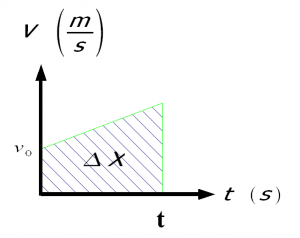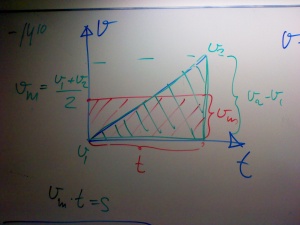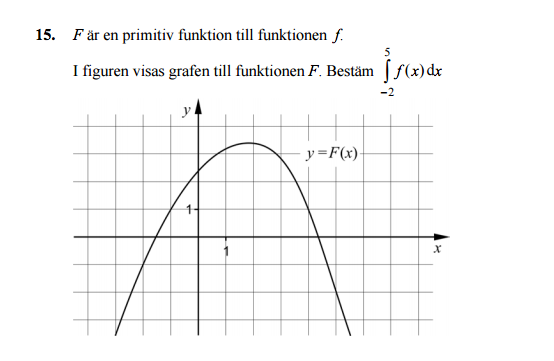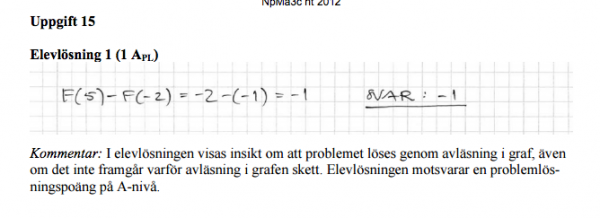Beräkna integraler
| Definition |
|---|
|
För en funktion f som är beroende av variabeln x och kontinuerlig på [a,b] beräknas integralen av f på följande vis:
där F är en primitiv funktion till f. |
Exempel från fysiken

Jämför med mekaniken, sträckan är arean under en vt-graf.
Begynnelsehastighet och förändring av hastigheten
Acceleration är lika med hastighetsökningen per sekund. Vid en konstant acceleration a, gäller då att:
- v = v0 + at
v0 är hastigheten vid start och t är så klart tiden från start.
Exempel: Fru Gran tapper en blomkruka genom fönstret. Vilken hastighet har den 1,5 sekunder senare?
- t = 1,5 s. a = g = 9,82 m/s2.
- v = at = 9,82 m/s2 * 1,5 s = 14,7 m/s
Arean
Arean under en vt-graf är lika med sträckan. Tänk att medelhastigheten * tiden = sträckan.
- vm = (vefter - vföre) / 2
Men sträckan är ju vm * t och det kan man ju se som arean av cen triangel som bildas av grafen i vt-diagrammet.
naturvetenskap.org ger en beskrivning.
Animering av sträcka under vt-kurva
<swf width="600" height="400">/images/FysikA_s_e_area_u_vt_kurva_2.swf</swf>

Khan om sträcka = area under vt-kurva
Sträckan
- s = v0t + at2/2
Geometriskt bevis
Wikipedia: Fundamental_theorem_of_calculus

For a continuous function y = f(x) whose graph is plotted as a curve, each value of x has a corresponding area function A(x), representing the area beneath the curve between 0 and x. The function A(x) may not be known, but it is given that it represents the area under the curve.
The area under the curve between x and x + h could be computed by finding the area between 0 and x + h, then subtracting the area between 0 and x. In other words, the area of this “sliver” would be A(x + h) − A(x).
There is another way to estimate the area of this same sliver. As shown in the accompanying figure, h is multiplied by f(x) to find the area of a rectangle that is approximately the same size as this sliver. So:
- [math]\displaystyle{ A(x+h)-A(x) \approx f(x)h }[/math]
In fact, this estimate becomes a perfect equality if we add the red portion of the "excess" area shown in the diagram. So:
- [math]\displaystyle{ A(x+h)-A(x)=f(x)h+(\text{Red Excess}) }[/math]
Rearranging terms:
- [math]\displaystyle{ f(x) = \frac{A(x+h)-A(x)}{h} - \frac{\text{Red Excess}}{h} }[/math].
As h approaches 0 in the limit, the last fraction can be shown to go to zero, which implies
- [math]\displaystyle{ f(x) = \lim_{h\to 0}\frac{A(x+h)-A(x)}{h}. }[/math]
This implies f(x) = A′(x). That is, the derivative of the area function A(x) exists and is the original function f(x); so, the area function is simply an antiderivative of the original function. Computing the derivative of a function and “finding the area” under its curve are "opposite" operations. This is the crux of the Fundamental Theorem of Calculus.
Läs gärna vad Wikipedia skriver om Analysens_fundamentalsats även om det är på en hög nivå för det är så häftigt.
Förklaring med hjälp av Riemannsumman
Kan man tänka sig någon trevlig frågeställning som ingång till integralerna?
Börja med att visa Riemannsumman för att ta reda på arean under en graf.
GeoGebra om Riemannsumma in här
Övning Riemannsumma i GGb
| Uppgift |
|---|
| laborera själv i Geogebra
Denna GGB ger dig möjlighet att flytta stapeln och att testa olika funktioner. Du kan ändra på antalet staplar och se hur det påverkar beräkningen. Vad lärde du dig av denna övning? |
uppg 2
Testa denna: http://www.geogebratube.org/student/m11330
Hur hanteras negativa areor?
Uppg 3
Man kan skapa Riemannsummor mellan två funktioner:
Exit card
En kunskapskontroll lämplig för lektionesns avslutning.




